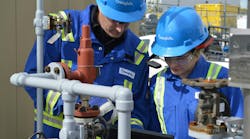Natural gas opportunities and trends continue to evolve due to the need of municipalities to better monitor natural gas usage as well as equipment maintenance. As a natural resource, natural gas is an outstanding available commodity that needs to be nurtured and managed.
How will this happen in 2020? It will be through the internet of things (IoT) systems and instrumentation. As good stewards of the resources, we see the newest trends in industry gear up to lead the IoT sectors.
The key to IIoT is getting the right information to the right person at the right time.
On the resource extraction side, new methods and new transport technology reduce costs but require a more Six Sigma-based approach to reliability and predictability. This means data. Six Sigma and analysis of the data-gathering systems provide information to limit downtime, and analyzing the data with artificial intelligence (AI) predicts future failures.
In the field of natural gas and instrumentation, safety is a high concern that needs to be constantly monitored and maintained. Leaks can be expensive and dangerous — and a problem that can go undetected.
The good news is, technology is creating new, safer instrumentation. Mixing in the gas (mercaptan), which is used to give it that rotten egg smell, can be monitored. Natural gas is odorless and colorless in its natural state. Mixing and blending valves, sensors and instruments help determine the percentages mixed in, and analyzers are used for checking the gas spectrum range to keep the gas in the optimal range. Monitoring instruments provide feedback to the pressure levels that help detect leaks. Testing instruments measure contaminant levels in the gas. Some of these contaminants can cause corrosion and premature wear.
The same concerns of carbon monoxide poisoning that make it a hazard for consumers is also a hazard in transport and in production, so careful monitoring is required.
Where do we get this data? Sensors. In the valves, external to valves, enclosed in noncorrosive environments — basically everywhere. The more information and data points acquired, the better the picture is.
In the past, a minimal number of sensors were used that had a higher failure rate of their own. Now, improvements in the packaging that the sensor is enclosed in and the sensor can work with limited parts, and optimized hysteresis curves allow the sensors to run longer with less movable parts in less than optimal environments.
Transducers are being developed with improvements that allow them to produce data without direct contact that was necessary in the past.
Transmitters are transmitting more data with less downtime and using smarter communication protocols. In the past, data was gathered in old systems that would bog down when it processed too much information. Also, the transmitters were slow to respond and were running open loop, in many cases, without a confirmation that the data was received. Now, smarter compilers store the data until confirmation is received, and then it resets the memory stack and continues to store, even through system outages.
Lower power requirements allow these systems to operate for longer periods of downtime and still gather data.
All of the aforementioned developments are now incorporated into the instrumentation and field systems — from the natural gas fields to the consumers. The hardware used to transport, gather and regulate are all optimized with IoT.
One of today’s concerns relates to extreme temperatures with the instruments in extreme heat and extreme cold. Being exposed to the elements means that remote access and transmission are more important than ever. In rural locations, this is particularly imperative.
Other safety concerns include flammability and combustibility. Improved monitoring and regulation allow for systems to integrate their own pressurized system, so if a leak occurs, it can be handled with automatic shutoffs performed remotely and monitoring the environment. Even spectrum analyzers can be drone-operated. This can also perform air quality inspections and leak monitoring with video analysis.
Today’s instrumentation is evaluated, and data is fed back into the systems for artificial intelligence (AI) analysis to predict failures and forecast replacement schedules. We can also map data from one instrumentation package to another, thus giving a better cross-reference of information from multiple sources and analyzed for key performance indicators, which can be used to set automatic actuation sequences in place. This might mean something as simple as adjusting a pressure automatically or it might mean scheduling replacement and downtime so we can route a source to another pipe or line.
Data analytics will continue to change instrumentation in the natural gas world.Joseph Zulick is a writer and manager at MRO Electric and Supply. For more information, go to mroelectric.com and josephzulick.com.



